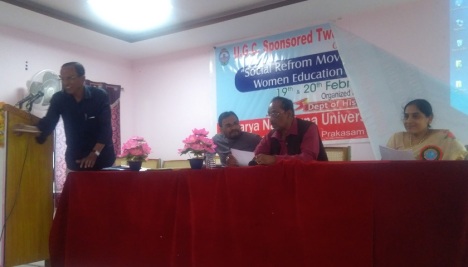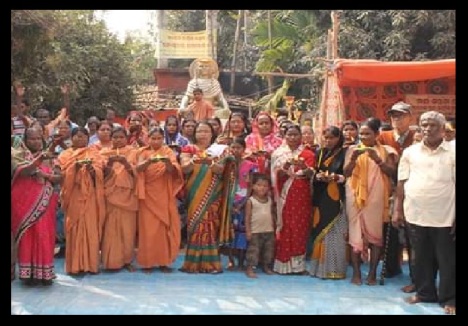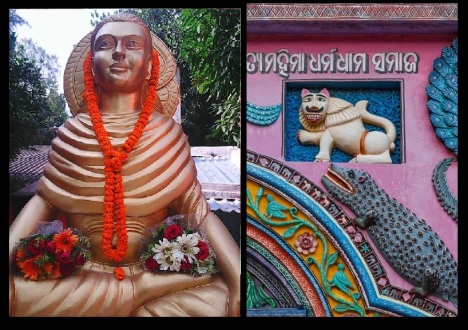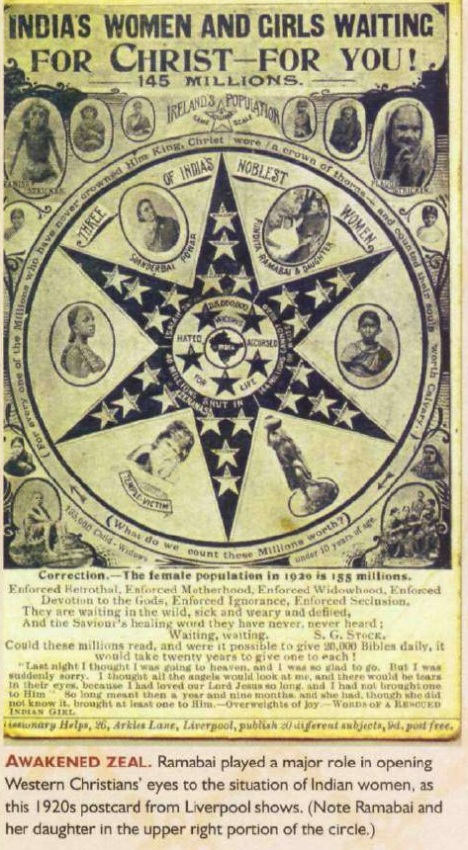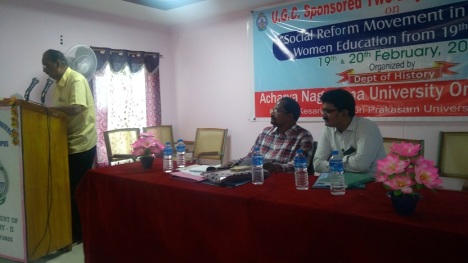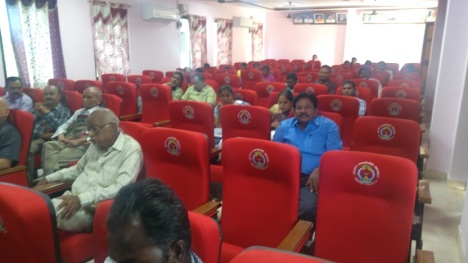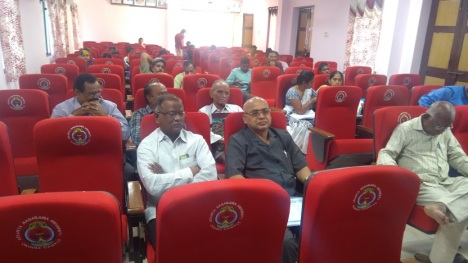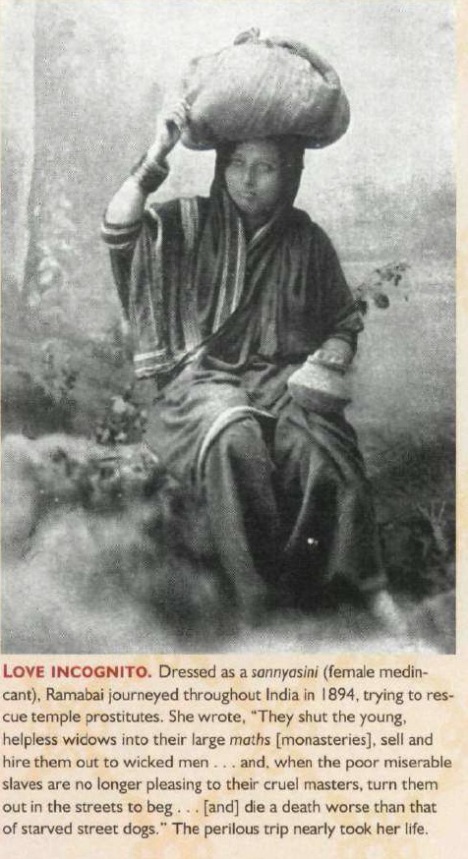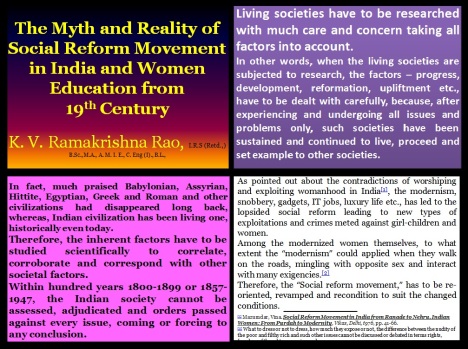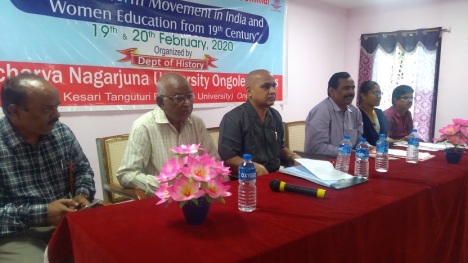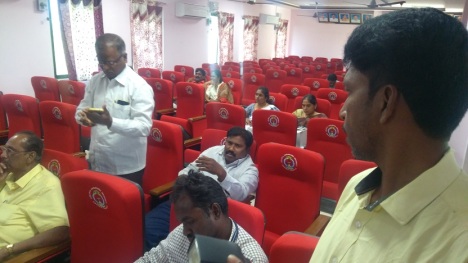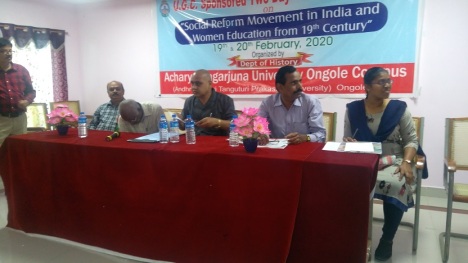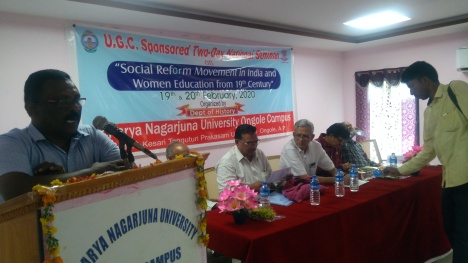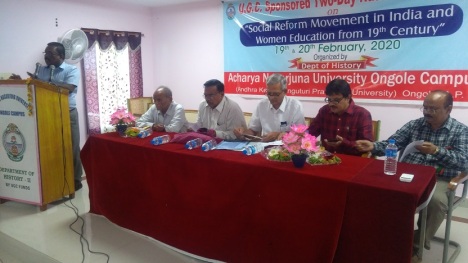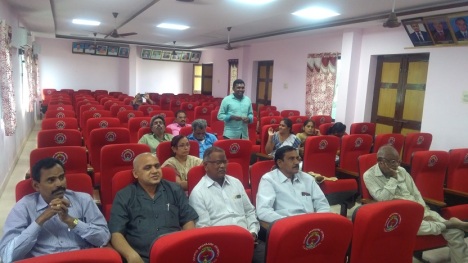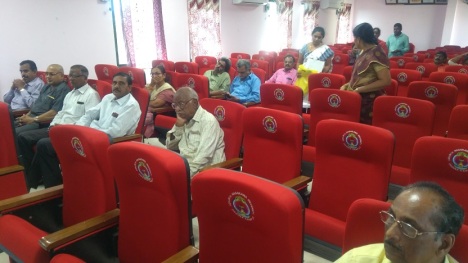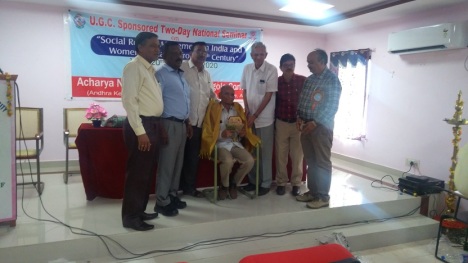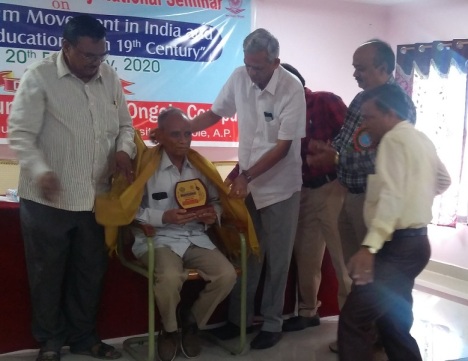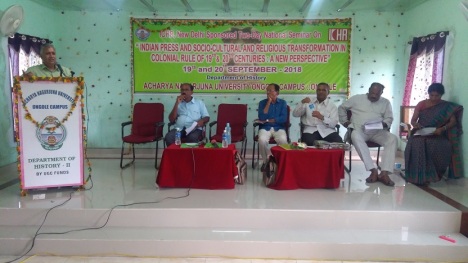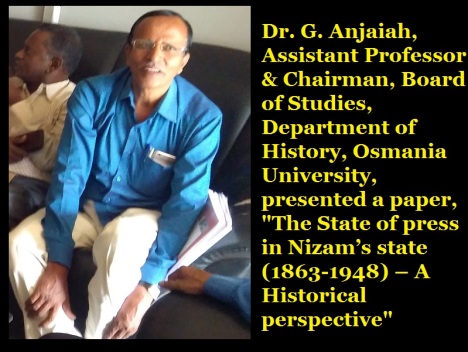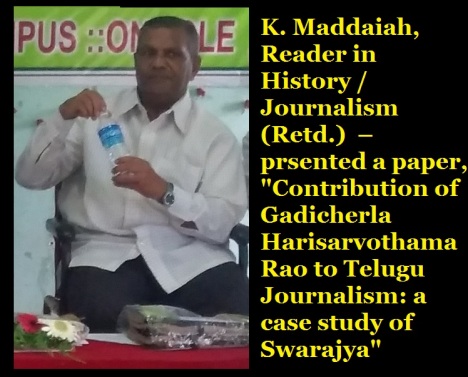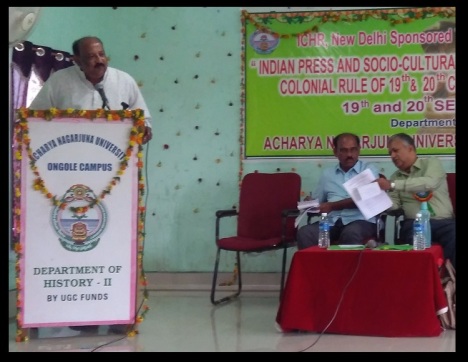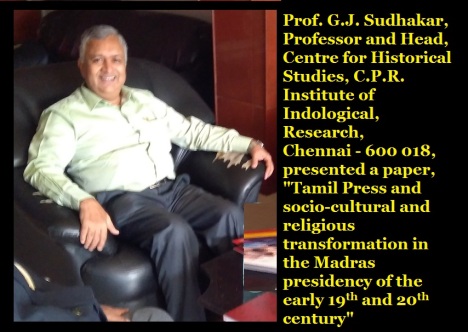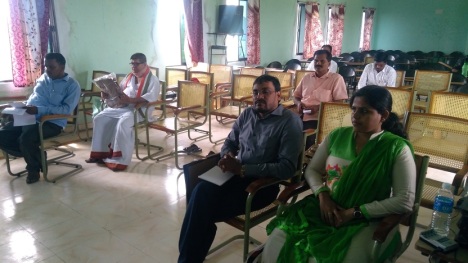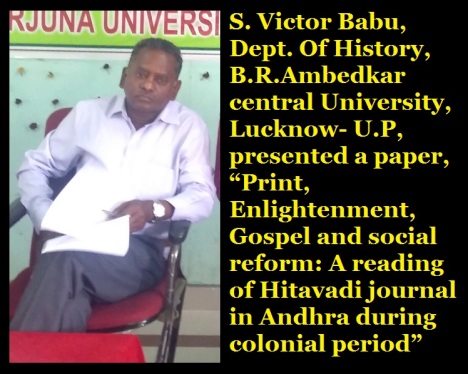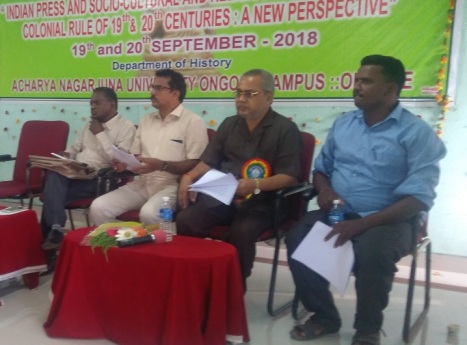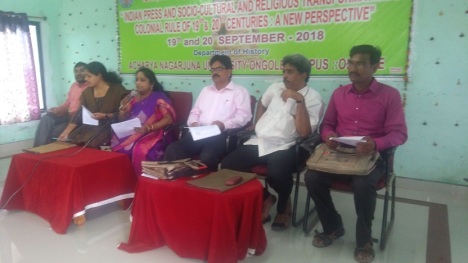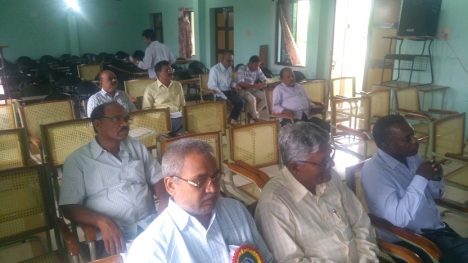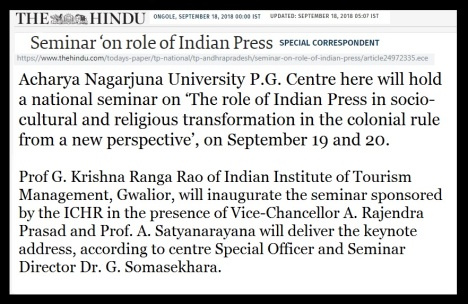National Seminar on “Historicity of Ramayana” held at Ongole, Andhrapradesh on November 8th and 9th 2014.

Historicity of Ramayana – stage
The question of writing Indian history from “national perspective”: “The Hindu” reported that as part of efforts to write Indian history from “national perspective”, Bharatiya Itihas Sankalana Samiti (BISS) held a seminar on Ramayana here on November 8th and 9th 2014 at Ongole, Andhrapradesh[1]. BISS State unit secretary K. Lakshmana Rao said “Indian history had been distorted during the British rule”. Research papers were invited from scholars on various topics, including Ramayana’s historicity, by October 15 to BISS functionary there in Ongole P. Ramachadramurthy, whose contact no. was given – on 9640300507[2]. Writing history in the “national perspective” cannot be questioned, criticized or suspected, when “Indian history” written down and available in the print has been incomplete, unfinished and imperfect, as many important dates have not been fixed conclusively, but arrived at in a hurried way ignoring many material evidences and thus forced on Indians, during the last 100-150 years. Just because writing of Indian history the “national perspective” is anathema, others cannot think that what has been written has been not in the “national perspective”. In fact, such proposition becomes precarious in the academic circles[3], as some of them have already made such divide among themselves involving Rama, Ramayana and historicity[4]. The delegates were accommodated at the Swati Kalyanamantapam, Ongole and the entire proceedings of the seminar academic and as well as hospitality were held there comfortably.

Registration of the delegates at the Swati Kalyanamandapam
Theme of the National seminar and the subjects suggested: Topic Earlier, the organizers invited to present your research papers with an insight into the following topics in Ramayana:
- Ramayana period
- The Sages and Rishis (Scientists)
- Administration
- Urban Culture & Social Life
- Public life
- Dharma (Duties)
- Special Women characters
- Lakes & Rivers
- Tribal Life
- Genealogical Histories & Kingdoms
|
- Astrological & related sciences
- Path of Rama’s Journey
- Geographical science
- Science of Weapons
- Science of Industries
- Marital relations
- Military Strategies and Techniques
- Science of Mantra Sastra
- Rearing of children
- Influence of Ramayana on other countries
|

Organizers at the Seminar hall before inauguration on 08-11-2014
They also gave the following Instructions to submit Research Papers and Registration :
- Research Paper should not exceed 5pages of A4 size one side pages in Font Size 12. Both the soft and hard copies have to be submitted on the first day of the seminar.
- To register, send one page synopsis of your topic emphasizing your key points on or before October 15th to the email id: yogabalug@gmail.com. Participation is strictly based on registrations made in this format.
- The entire paper cannot be read during the seminar. Please project only the highlights within the allotted 10 minutes duration.
- A registration fee of Rs.200/- towards participation in the seminar is to be paid on the first day of the seminar.
- Research Papers can be submitted in any of Telugu, Sanskrit, Hindi or English languages.

Getting ready to light lamp for inauguration
Inauguration of the seminar (08-11-2014): The seminar was inaugurated as per the schedule on 8th morning, though the Chief Guest Hon. Sri Siddha Raghavaa Rao, Ministry of Roads and Buildings, A. P. did not turn up. As Sri P. Ramulu, the key-note address presenter was also not turned up, Sri M. M. Rao spoke. The organizing secretary of ABISY, Sri Balamukund Pandeya also did not come with his preoccupation. The Sectional presidents Dr / Sri D. Ramanadha Sastry, Nelamraju Pardhasarthi, J. Janakirama Sharma, A. Hanumantha Rao, K. Srinivas, and B. V. Subba Rao were present. The lighting of lamp and other rituals went on and then the technical sessions started.

Lighting lamp
Ramayana is no myth, claim experts at seminar (as reported by “The Hindu”[5]): “Ramayana is no myth. It is very much an historical account of the great emperor Rama who shaped the character of Indian civilization for centuries and also the Indian diaspora elsewhere including southeast Asia.” This view was articulated by speakers at a seminar on the historicity of Ramayana organised by Bharatiya Itihas Sankalana Samiti (BISS) here on Saturday (08-11-2014). Speaking during the inaugural session, archaeologist[6] M.M. Rao said archaeological evidence was abundant both in India and southeast Asia, Egypt and Afghanistan to prove the historicity of the Lord Ram. Indian history should be rewritten from Indian perspective, he added. The Indian Council of Historical Research (ICHR) should promote research in India and other countries including Southeast Asia to enlighten people on facts of history, BISS organising secretary D. Mohan Rao said. Over 100 research papers were presented at the seminar on various aspects including the lives of women during the Ramayana era, seminar organising committee president P. Ramachandramurthy said[7].

A section of the audience
The front and back cover of the Abstract volume issued to the delegates –

Abstract volume issued to the delegates – front cover
The papers and paper presenters: The paper presenters had been from the Universities of SCSVMC, Kanchipuram, Rastriya Sanskrit Vidhyapeet, Tirupati, Osamania, Sri Venkateswara, Krishnadevaraya, and the Institute for the Study of Ancient Indian Arts and Sciences, Chennai. More than 85 / 100 papers were received, most of them were in Telugu and Sanskrit one in Hindi and few in English[8] as listed below.
|
Title of the paper |
Paper presenter |
|
Sanskrit papers |
|
| 1 |
Srimad Valmiki Ramayana manusrutyavisheshstri patrani |
Mahatnti Rajyalakshmi |
| 2 |
Valmiki Ramayane – Suktisamiksha |
Gowri sankara Shenai Devadas |
| 3 |
Adhunikale Ramayanavaishisytyam – Ekamadhyayanam |
Balakrishna |
| 4 |
Bharatashya bhatrubakti: ekam anusilanam |
Jayamanikya Shastri |
| 5 |
Ramayane-stri-patra |
Harikrishna Kondapalli |
| 6 |
Srimadramayane srushyaha: (Bhrahmarsharshyaha). |
Sujatha Raghavan |
| 7 |
Abhinandhakruta ramacarita me nyayadharshana |
Sridhar |
| 8 |
Ramayane pramukh stripatranam parisilanam |
Hiralal Dash |
| 9 |
Ramayane dharmastatha naitikta |
Thakur Rana |
| 10 |
Ramayane pramukpatranam rastrabakti |
Sudeshana Dash |
| 11 |
Valmiki: bharatiya samkruti |
Lanka Venkatasubramanyeswar Sharma |
| 12 |
Purushata catushtayam – srimath valmiki ramayanam |
Pawan Kumar |
| 13 |
Ramayanashya Pandulipivishyakamekam sarvekshanam (A Manuscript survey on Ramayana) |
G. Arjun Kashyap |
| 14 |
Ramayane sainikavyavasta |
Narendrakumar |
| 15 |
Srimathramayane jyotisham |
Harikeshasahu |
| 16 |
Adharsharamarajyastapane – sitayashsasyogaha |
Asavadi Sudhama Vamsi |
| 17 |
Ramayana yatra |
Shivanag Sandip |
| 18 |
Ramarajyam |
Shekar Reddy |
| 19 |
Valmikiyaramayane jyotisham |
Pradeep Sharma |
| 20 |
Jyotishashastranusare ramavayavarnanam |
Rojalin Sahu |
| 21 |
Ramayanadhyastaya haridhasidhantavagishaviracitram vadakiyatapanatakasyam anushilanam |
Sumanta pramanik |
| 22 |
Srimathrramayane dharmapatipadhanam |
Lakshmi Tulasi |
| 23 |
Ramayane adhyanini samajikam adhyayanam |
Charan |
| 24 |
Srimatharamayane rushinam varnanam |
Kasturi VVSAR Chandekhar |
| 25 |
Vidhyaparinayananatakadhyashtaya |
Shaik. Jamal Basha |
| 26 |
Mimamsamatdhyataya (ritya) ramayane yaga |
Venkat Narayana |
| 27 |
Hanuman uttamo dhuta |
Ravi Teja |
| 28 |
Srimathramayane yagaha: tadhmarshyaca |
Nageswar Rao |
| 29 |
Srimathramayane sharanagatitatva |
T. G. Ranga Ramanujacharlu |
| 30 |
Srimathramayane ramalakshmanyo: adharshabhraturtatvam |
Lakshminarayanan |
| 31 |
Ramayane prashasanatatram |
H. Arya |
|
Telugu papers |
|
| 32 |
Ramayanamulo Stripatrala jautityam |
SeshavaraLakshmi |
| 33 |
Strinityachaitanyaspurti-Baktasabari |
Nareshkumar Naik |
| 34 |
Ramayanamulo vishista strilu (Sita) |
Dasaratha Ramaraju |
| 35 |
Sundarakandaloni hanumanthuni karyanirvahana dakshyata |
Ramanujula Reddy |
| 36 |
Sri Ramayanamulo nadhinadhamuli |
Mrs and Mr Chiralavamsa Vamsi Krishna |
| 37 |
Ramayanamulo Viswamitradu |
Jagadesh |
| 38 |
Ramayanumulo Ramuni Vanavasam |
Sasikumari |
| 39 |
Ramayanam Mallayudddham leka Bahuyuddham |
Jayalakshmi |
| 40 |
Ramayanumulo Rishulu |
Venkateswarlu |
| 41 |
Srimath Ramayanamu – Ramarajyam – Rajadharmam |
Narasimha Acharya |
| 42 |
Ramayanam – Dhanurvigyanam |
Himachalam |
| 43 |
Prabhuswamyamlo Prajasamyam |
Ravishankar |
| 44 |
Sri Ramayanam – Baktirasam |
Ravi Kishore |
| 45 |
Mahasadhvi Mandodhari |
Sudharshan |
| 46 |
Mahabalasali Vali |
Dheena Dayal |
| 47 |
Ramayanmulo Naitika Vilavulu |
Mukkaranna and D. Nallanna |
| 48 |
Ramayana kalamulo Vidhyavidhanam |
Murali Mohan |
| 49 |
Srimathramayanulo dharmika samastalapalanaku sampadhincina vishesharta |
Sriramulu |
| 50 |
Ramayanumulo vishesha stri patralu |
Mallikarjuna |
| 51 |
Ramayanumulo Jatayu patra |
Ashok Kumar |
| 52 |
Ramayanumulo Rishulu |
Venkateswaraulu and D. Prurosottam |
| 53 |
Ramayanamu – Dharmalu |
V. Sai Babu |
| 54 |
Ramayanamulo Maharishilu |
Siva Prasada Reddy |
| 55 |
Ramayanakalamulo Manavasambandalu |
Ramakanta Sharma |
| 56 |
Ramayanumulo Pakshilu |
K. S. Pavan Kumar |
| 57 |
Ramayanumulo Vishista Stripatralu |
Ravindra Babu |
| 58 |
Ramayanam – Strijivanam |
Sampurna |
| 59 |
Ramayanumulo Vyvahika jivanam |
Siva Praveen |
| 60 |
Ramayanumulo Manavata Dharmalu mariyu viluvalu |
L. Narasimha Prasad, M. Ramachandra Murty |
| 61 |
Ramayanumulo Stripatralu: Auicityamu mariyu pradharnayata |
R. lalita and M. Ramachandra Murthy |
| 62 |
Ramayanamulo kutumpa vivasta |
Gurujada |
| 63 |
Ramayanumulo Rishilu |
Mallikarjuna |
| 64 |
Ramayanumulo Pillala pempakam |
Sitaramamurthy |
| 65 |
Ramayanamulo Ramuni Toliprayanam |
Alamvali |
| 66 |
Ramayanamulo Samajika Jivanam |
Muthiyalappa |
| 67 |
Badhradhri Ramudu Ayodhya Ramuda, vera? |
S. G. Hanumath Prasad |
| 68 |
Ramayana sandhesham |
M. Tharakeswar |
| 69 |
Ramnayanam – Ayodhyakandam – Acharya-bavavisleshana |
Malakondaiah |
| 70 |
Ramayana Samajam – Samajikata |
Samiulla |
| 71 |
Ramayanam – Matrutvam |
Mrudula |
| 72 |
Women in Ramayana – Selected characters |
Sharanya |
| 73 |
Rama – the perfect role model for Dalit liberation: A counter, native and efficacious theology. |
K. Sathyapraksh Rao |
| 74 |
Monkey God in the Ancient Cultures of the World |
K. Chirta Rao |
| 75 |
Social Status as depicted in Ramayana |
Debajyoti Jena |
| 76 |
Tribal characters in Ramayana |
Srresamulu |
| 77 |
Ramayanamulo Dharmalu |
Venkateswarlu |
| 78 |
Ramayanamulo Vishesha Strtpatralu |
Bhardwaja |
| 79 |
Ramayanamulo – Rishulu |
Kameswari |
| 80 |
The Historicity of Ramayana and its spread in the West |
K. V. Ramakrishna Rao |
| 81 |
Ramayana, Mahabharata and Gilgamesh |
K. Vivekananda Rao |

Abstract volume issued to the delegates – back cover
During the paper reading session, there was some discussion about the “Historicity of Ramayana”, but by and large, that aspect was not taken care of, as had been mentioned. The first day seminar was concluded with a Bharatanatyam performance by the young girls of Manimekala Natya Sanga of Ongole.

A section of the audience – another view
The nature of papers and paper presenters: The paper presenters in Sanskrit had been HOD, Professor, Assistant Professor, lecturer, Research Scholar in Sanskrit of various branches like sahitya, nyaya, vyakarna, mimansa and so on. They talked, discussed, debated and argued in Sanskrit (So none could say that Sanskrit is dead). So also, the paper presenters in Telugu had such positions. As the titles reveal, not only the topics, but also the subject matter dealt with by the paper presenters show that they were about the literary glib, scholarly discourse, bookish syntax, epical prosody, poetic fantasy, lyrical rhyming, prosaic flow and so on. Though, it was a national seminar, the brief of the paper presented was not given in a language understandable to others. In fact, the research scholars have to give their brief in English even for the academic purposes. They had been of repetitive, monotonous and customary. They never touched upon the seminar theme the “Historicity of Ramayana”. When I conversed with them, I understood that they were not aware of the books written by H. D. Sankalia[9] (noted archaeologist), B. B. Lal[10] (former Archaeologial Survey of India Director General), D. C. Sircar[11] (eminent epigraphist) and others, the WAC-3 proceedings (New Delhi, 1995)[12], excavations conducted at the traditional sites connected with Ramayana and connected issues. Most of them did not know about the existence of Jaina and Buddhist versions of Ramayana and their interpolations[13], modification and recast of Ramayana in different ways[14]. The paper presenters even did not mention about the papers and proceedings volumes brought out by the earlier conferences and seminars conducted at national and international levels. Though some of them lamented for the mythologization of the epic, they never brought out the methods for demythologization in historical perspective.

A section of the audience – yet another view
inauguration went on with rituals.

P. Ramachandramurthy managing the show
Technical session.

Dr Sujatha Raghavan of SCSVMV presenting a paper
The paper reading session went on with active participation of the delegates.

Audience view – technical session morning 08-11-2014
The delegates were attending the session with enthusiasm.

Audience – another view – technical session morning 08-11-2014
The Sanskrit and Telugu papers reading sessions went on simultaneously.

Sanskrit session – Sastry of SCSVMV presenting a paper
From Sri Chandrasekhara Saraswati Viswa Vidhyalaya, Enathur, Kanchipuram one group of Sanskrit scholars had come and presented papers.

Sanskrit session –
Sri Hanumantha Rao, Sanskrit Pundit was heading another session

Sri Hanumantha Rao, Sanskrit Pundit was heading another session
On 08-11-2014 evening, there was a “Bharata natyam” program performed by Manimekhalai Dance Academy.

Young girls performing Bharata natyam
Cultural programme – another view

Young girls performing Bharata natyam
A request to Sanskrit pundits, scholars and experts: The Sanskrit professionals of all fields should tackle the question of dating and chronology of Vedas, Itihasas and Puranas. They should bring out the correct interpretation of the Kruta, Treata, Dwapara and Kaliyuga periods and correlate and corroborate with the events mentioned in the scriptures. As the “Indian history writers” of the Europeans used the data given in the Sanskrit literature about the dynasties and kings ruled, and corresponded with that of inscriptions, they should be rechecked to verify the correctness. As many Kings and Kingdoms were rejected as myth by them in spite of their recordings in the literature and inscriptions, they should be reassesses and scrutinized thoroughly. When the Jains, Buddhists, Greeks, Moghuls[15] and Europeans started interpolating the scriptures and the purpose should be exposed categorically. The myths that Dasaratha had 60,000 wives, Rama ruled for 10,000 years, Rana had many wives[16] etc., should be demythologized and the facts brought out. Other aspects like the existence of Pushpaka Vimana, three-four tusked elephants, dinosaurs like strange animals and birds etc., also should be fixed within the dating framework of geology if not history. The pseudo-works can also be identified and categorized accordingly, so that any vested persons or groups tried to exploit, the fact would be recorded to check them.

A scholar from SCSVMV presenting a paper on 09-11-2014 morning
Fundamental concepts, precepts, hypotheses and theories could have been taken into consideration: Unfortunately, except 5 papers all delved upon the routine matters of Rama-bakti, popularity of Ramayana, characters, etc., without touching upon chronology, dating, archaeology or historicity. Though many delved upon the “female characters” of Ramayana, they did not discuss critically and decisively in the modern context and the social issues, the Indian society facing today. Many fundamental concepts, precepts, hypotheses and theories were taken into consideration –
- that Bharat / India of Ramayana period was different from that of today in all aspects;
- the geographical setting, location of the places, hills, rivers etc., were different (historical development of knowledge of geography, geology, astronomy, longitude-latitude to locate the places etc);
- chronological correlation and corroboration of events consonance with the archaeological evidences;
- sculptural depiction of Ramayana, characters and other related aspects in India and outside and their correlation and corroboration;
- the dating of Vedas, Epics and Puranas connecting with Ramayana characters and events;
- overcoming or refuting the hypotheses and theories that Valmiki copied from Homer, Gilgamesh etc., effectively with the expertise of Sanskrit;
- the issues related to the origin and development of script, language and literature –
- script, language and literature used in the epical context,
- origin of philosophy (which is considered as the origin of all modern subjects) and its dating
- correlation and corroboration of literary evidences with the material evidences in historical perspective.
- the importance of recitation (or recording literature in memory),
- necessity of writing down an some material medium,
- the lag between such transitional periods, the nature and longevity of the memory and the material medium used,
- the continuity of preserving the “writing down” material, availability of them etc.,
Here, the dating of the present-available “written-down” material medium could not be the date of the historical processes went on in stages.

Second day morning session – audience
The second day session was also conducted first jointly and then, separately to cover all papers.

audience – another view
Sri Ramakanth Sarma, Tirupati presenting his paper.

Sri Ramakanth Sarma, Tirupati presenting his paper.
The paper reading session.

09-11-2014 paper reading session
Though, there was rain on the second day, some local delegates joined and presented papers.

09-11-2014 paper reading session
A large number of women-scholars participated and presented papers.

A large number of women-scholars participated and presented papers.
The VIPs on the stage during the valedictory function held after lunch.

Sri Ramanadha Sastry, Janakirama Sastry, Hanumantha Rao, Chidambaram Sastry on the stage during valedictory function
The second day proceedings and Valedictory function (09-11-2014): The technical session of paper reading continued on the second day (Sunday, 09-11-2014). Suddenly, the climate was changed in Ongole and there was heavy downpour of rains. After paper reading session and lunch the valedictory function started. During the valedictory function, some important points were brought out by the scholars who presided over different sections of the proceedings.
- Original Ramayana composed by Valmiki contained only 24,000 verses.
- The Jains and Buddhists manipulated the epic Ramayana to throw slur on Rama, Sita, Agalya and other characters, as Ramayana was so popular with the mass even during those periods.
- Rama and Sita were considered as “Anna sakti” i.e, “power of food”. Sita was born out of earth and during ploughing of land, she was discovered as baby. So also Rama in giving life to Agalya, so that the stone turning into life from the dry and parched land to fertile. The “payasam” producing Rama, Lakshmana, Bharata and Catrugana has been also involving such “power of food”[17].
- The controversies like killing of Chambuka by Rama were one of them[18].
- Most of the paper presenters did not stick to the theme of the seminar, “Historicity of Ramayana”.
- Translations of Ramayana also played an havoc for misinterpretations in other languages[19].
The first four points were clarified by Sri Chidambaram Sastry, five by J. Janakirama Sharma.

audience during the valedictory function
The work of organizing and conducting of seminar or conference has been involving man and material. When much money, energy and others were spent on the conduct of seminars, it is not known why and how they are become emaciated on such repetitive issues that have been well-recorded already in many-many books. The papers received could have been scrutinized before and the presenters could have been advised to revise, reorient and redraft their papers in the thematic frame work of the seminar. Sri J. Janakirama Sharma pointed out this.

Sri Mohan Rao briefing the proceedings
All the persons – from philanthropists to volunteers who worked for the conduct of the seminar were honoured with mementos.

…………………………, …………….., Koti Lakshmana Rao, M. M. Rao
During the valedictory function, the scholars brought out some important points as mentioned above.

Janakirama Sastry, Ramanadha Sastry, Hanumantha Rao
Sri Mohan Rao was clarifying some points.

Sri Mohan Rao was clarifying some points.
The audience during the valedictory function

The audience during the valedictory function
Particularly, the food offered by Baba Ramdev group was produced by natural manure and healthy. Food packets were provided to the outstation delegates by them. By 5 pm evening, the seminar proceedings were over and the delegates started moving out to catch buses and trains, as the climate was rainy. They may be meeting again in another seminar or conference with their past memories.

the AP – BISS group
Rewriting of Indian history: P. Ramachandramurthy, president of the committee that organised a national seminar on ‘The Historicity of Ramayana’ said, “Much of Indian history has been distorted, and this needs to be corrected”[20]. Briefing reporters on Monday (10-11-2014), he said 120 papers were presented during the two-day seminar by scholars, and that they would be brought out in the form of a book later[21]. However, how it has to be rewritten has not been brought out. As already, historians have been divided on this issue also[22] as reflected in the IHC proceedings, RJB-BM and Ramasethu Court cases, and then, as happened in the case of CBEC books as to what constitutes “right” or “scientific” history[23] etc, a consensus may have to be arrived at immediately, as the objections raised by the historians who accused “saffronization” of text books was held void already. Enough has been pointed out as to how the accusing group of historians has also been indulged in the ideologization of historiography without any balance[24] and therefore, again, such outpour need not be brought to the public domain. As now youngsters, particularly who pursue and pursued and qualified in the subjects of science and technology, have been exposed to knowledge, they have capacity to think scientifically and understand what is right or wrong and they would not be worried about “right” or “left” as “centre” in India has never identified by itself or by others, as only “left” dominated[25]. In the Supreme Court judgment dated 12th September, 2002, pronounced in the matter of “The National Curriculum Framework for School Education, 2000”. the following issues were discussed and the Court decided that there was nothing in the issues[26]:
- Regarding Sanskrit language.
- Regarding Vedic astrology.
- Regarding Vedic Mathematics.
- Regarding Hindu festivals being treated as National Festivals.
Therefore, now historians need not confuse the issues of nationalism, Marxism, secularism, communalism etc., and come forward for updating the Indian history with the material evidences obtained during the last 60 years.
.
[1] http://www.thehindu.com/todays-paper/tp-national/tp-andhrapradesh/seminar-on-ramayana-from-tomorrow/article6572756.ece
[2] http://www.thehindu.com/todays-paper/tp-national/tp-andhrapradesh/seminar-on-ramayana/article6227448.ece
[3] The suspecting of writing history in the “national perspective”, may pose a counter question of anything “written down in anti-national perspective”. Sir Robert Eric Mortimer Wheeler, 5000 years history of Pakistan: An archaeological outline, London, 1950. He was in Pakistan during 1949 and 1950, as an archaeological adviser in Pakistan helping to establish the Archaeological department of Pakistan and National Museum of Pakistan at Karachi. As Pakistan paid him, he faithfully wrote such history for Pakistan!
[4] The WAC-3 proceedings, the Court cases and judgments of Ramajanmabhumi and Ramasethu give enough proofs and evidences to prove how the responsible Indian historians behaved differently and strictures passed by the courts for their wrong presentation of facts.
[5] The Hindu, Ramayana is no myth, claim experts at seminar, Ongole, November 9, 2014.
[6] M. M. Rao is not an archaeologist, but as “The Hindu” has mentioned, it has to be taken seriously as to whether it mentioned euphemistically or otherwise.
[7] http://www.thehindu.com/todays-paper/tp-national/tp-andhrapradesh/ramayana-is-no-myth-claim-experts-at-seminar/article6579469.ece
[8] This is based on the “Summary / abstract” book provided to the delegates with the kit.
[9] H. D. Sankalia, Ramayana Myth or Reality?, Peoples Publishing Company, New Delhi, 1973.
.……………, The Ramayana in Historical Perspective, MacMillan India Limited, New Delhi, 1982.
[10] B. B. Lal conducted excavations at traditional Ramayanic sites.
B.B. Lal, ‘Was Ayodhya Mythical City’, Puratattva, #X, 1978-79, pp. 45-49.
B.B. Lal ‘ Ayodhya of the Valmiki Ramayana: An Energising Debate on its Identification’, Puratattva, #XVI, 1985-86.
- B. Lal, A Note on the Excavations at Ayodhya with reference to the Mandir Masjid issue, paper presented during the WAC-3.
B.B. Lal, Director General (Retd.) Archaeological Survey of India
[11] D. C. Sircar, Problems of Ramayana, A. P., Govt. Museum Series No.19, Hyderabad, 1979, p.28.
…………………, Select Inscriptions, Vol.I, 1965, pp.77-78.
For the name “Rama” in earlier records, he draws attention to –
Luders’ List of Inscriptions, Nos.125I, 979.
[12] Jack Golson, What went wrong with WAC 3 and an attempt to understand why, Australian Archaeology, Number 41, 1995, pp.48-54.
[13] During valedictory function, Sri Chidambaram Sastry pointed out this point.
[14] However, I found that ABVP and others opposed the inclusion of “Three Huindred Ramayanas” of A. K. Ramanujam in the curriculum. This essay was taken from – Many Ramayanas, edited by Paula Richman, 1991, University of California Press, USA, pp.22-49.
[15] Allahupanishad, Yasur Vedam etc., composed by the Mohammedans and Christians for various purposes. The interpolations made in Bhavishya Puranam about the prediction of Jesus, Mohammed etc., should be pointed out.
[16] B. R. Ambedkar, The Riddles of Hinduism, Bombay.
[17] The origin of Ramayana as an “agricultural myth” has been pointed by many scholars already. Interestingly, the Zend Avesta mentioning Rama Hvastara also substantiate the myth.
[18] It is not found in the Valmiki Ramayana. Uttara Ramayana and other versions of Ramayana contain many manipulations that are not in the original Valmiki Ramayana.
[19] This aspect was pointed out earlier in April 2014 by Gottumukkala Venkata Satya Narasimha Sastry. Those who translated Valmiki Ramayana into different languages had interpreted the epic in their own way and it led to a series of controversies over the essence of Ramayana, according this scholar and president of ‘Aaswadana’ literary organization.
http://www.thehindu.com/news/national/andhra-pradesh/translations-of-ramayana-led-to-controversies-says-scholar/article5892070.ece
[20] The Hindu, Time to rewrite history from Indian perspective, Ongole, November.11, 2014
[21] http://www.thehindu.com/todays-paper/tp-national/tp-andhrapradesh/time-to-rewrite-history-from-indian-perspective/article6585105.ece
[22] Makkan Lal, The NCERT Social Science Books – False propaganda, Political Agenda and the “Eminent Historians”, Aligarh, 2002.
[23] Makkan Lal, A Review of the Class VI Text book of History (Ancient) published by the Govt. of West Bengal, Aligarh, 2002.
[24] Meenakshi Jain, Flawed Narratives – History in the old NCERT textbooks – A Random survey of Satish Chandra’s Medieval History of India, Delhi historians Forum, New Delhi, 2003.
[25] Atul Rawat, Prof. Arjun Dev: “An Eminent Historian” or a Fraud?, Delhi historians Forum, New Delhi, 2002.
[26] Supreme Court judgment dated 12th September, 2002, pronounced in the matter of “The National Curriculum Framework for School Education, 2000”, NCERT, New Delhi, 2002.
Filed under: andhra, archaeology, ayodhya, bharat, c-14, centre, civilization, colonial, conference, dating, Harappa, historicity, historiography, lanka, left, marxism, myth, objectivity, rama, ramayana, ravana, reality, rewriting, right, sankalia, sita | Tagged: Andhra, ayodhya, bharat, boundary, chronology, civilization, critical edition, dating, dwapara yuga, hanuman, historicity, historiography, interpolation, interpretation, kaliyuga, lanka, objectivity, ongole, rama, ramayana, sanskrit, sita, telugu, treta yuga, valmiki | 5 Comments »
